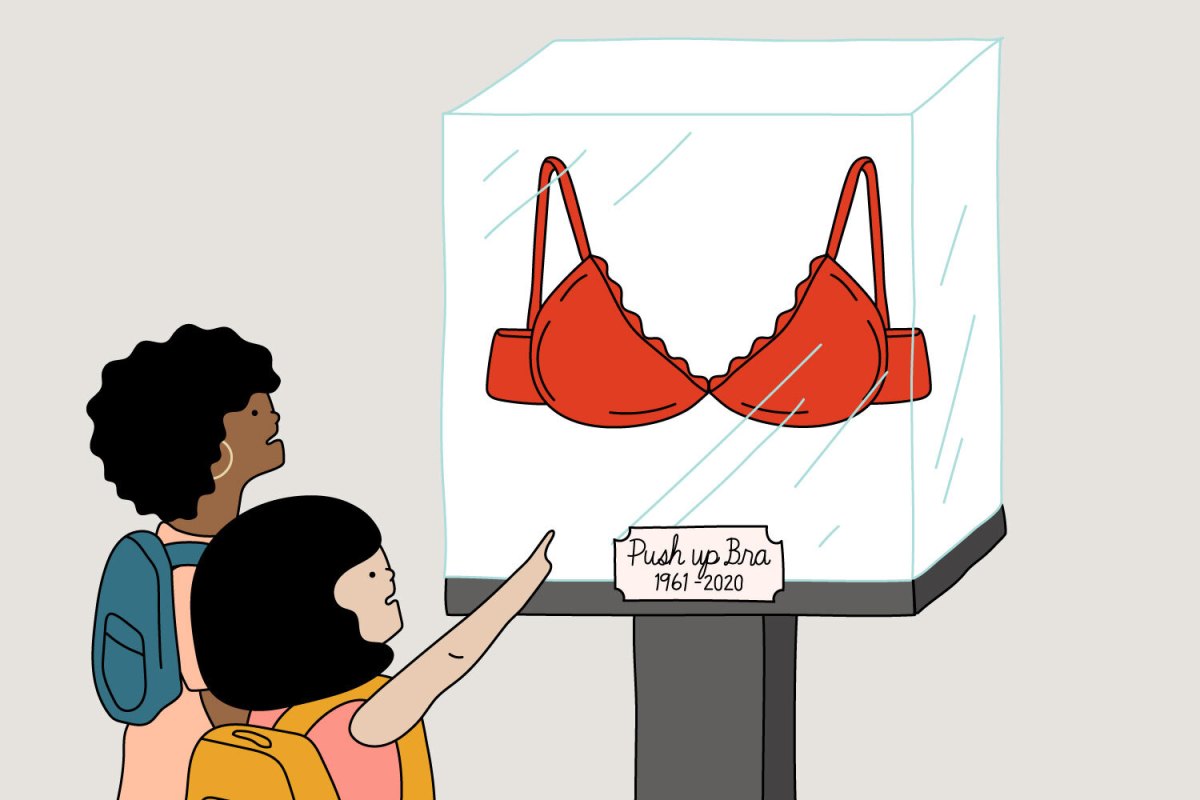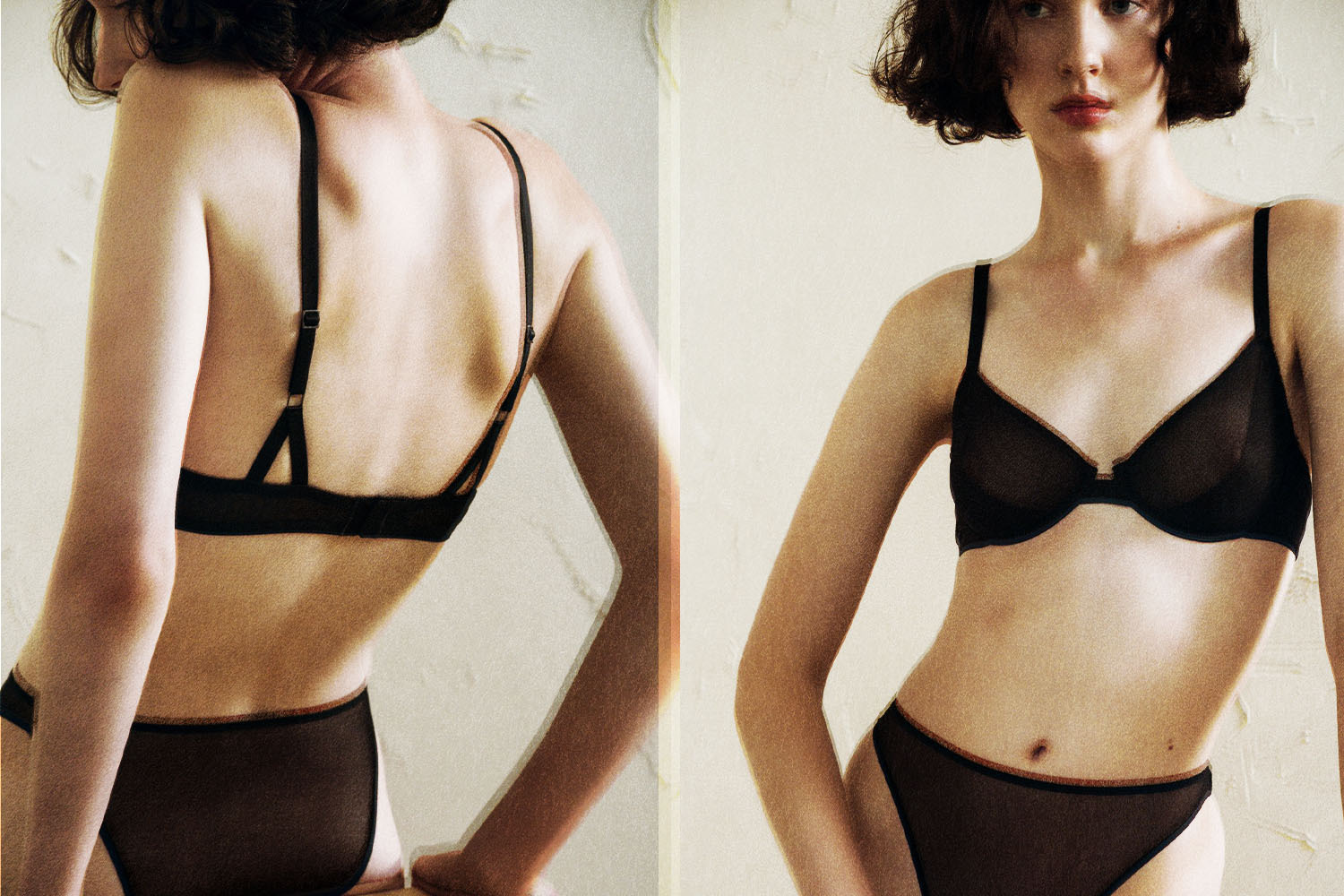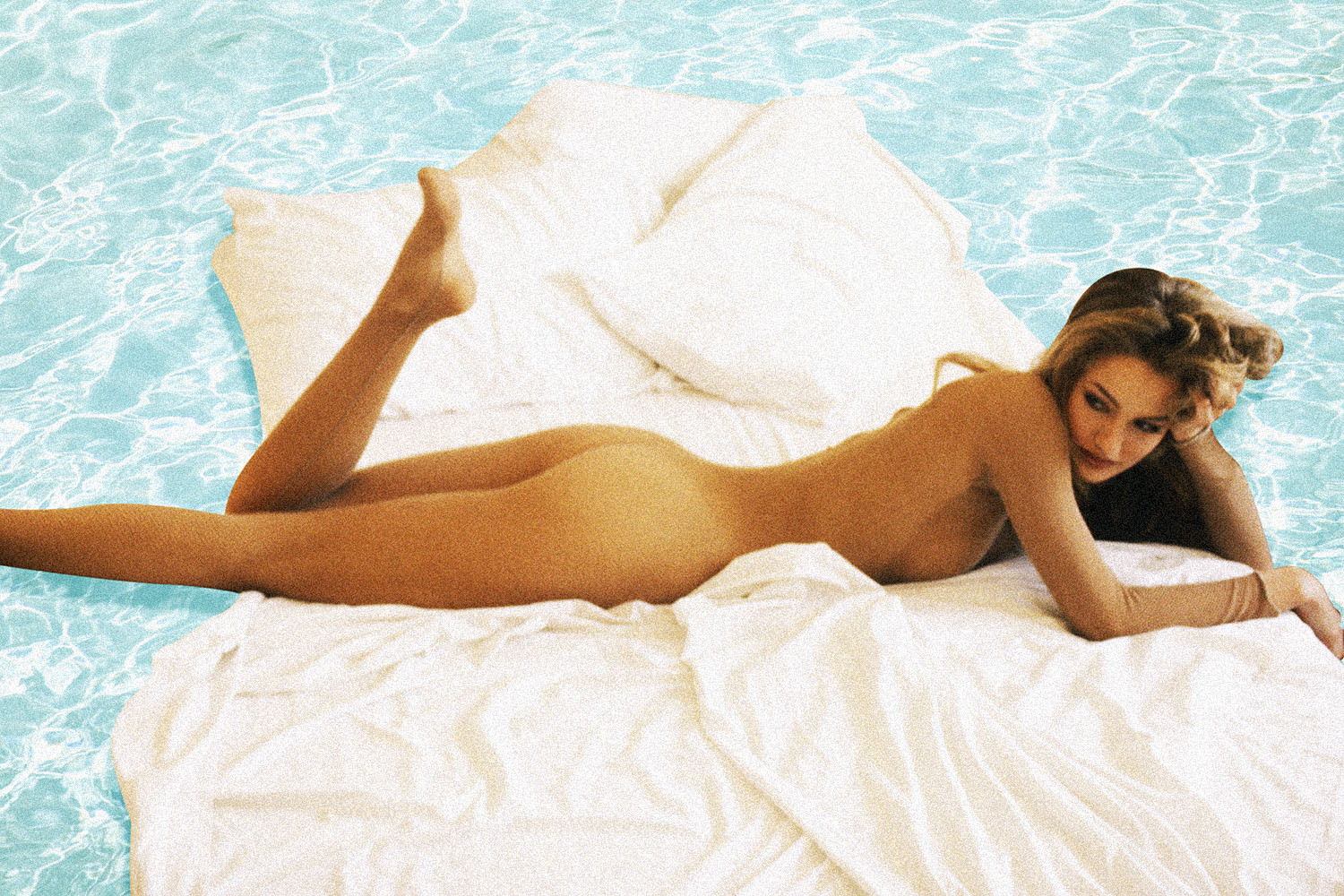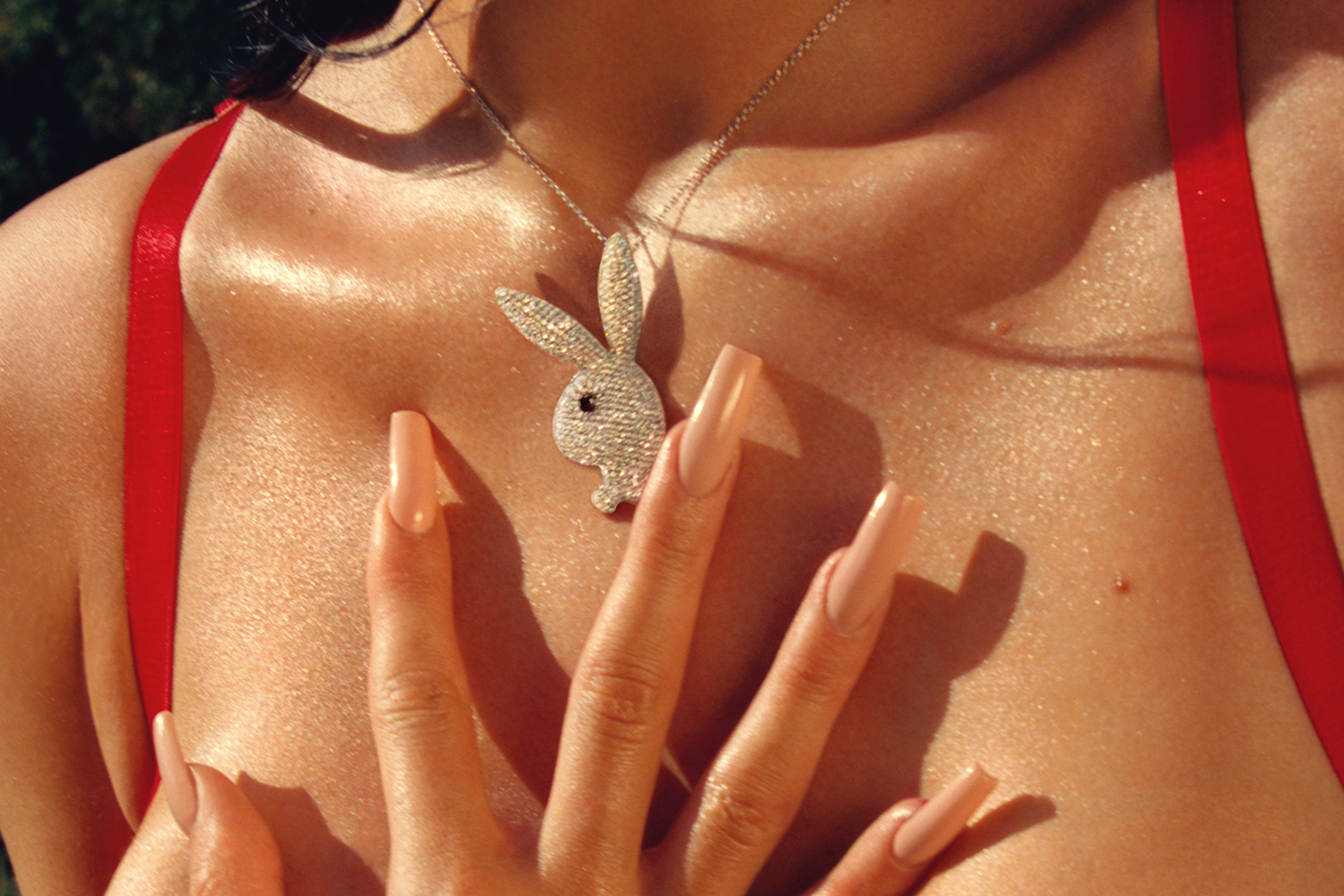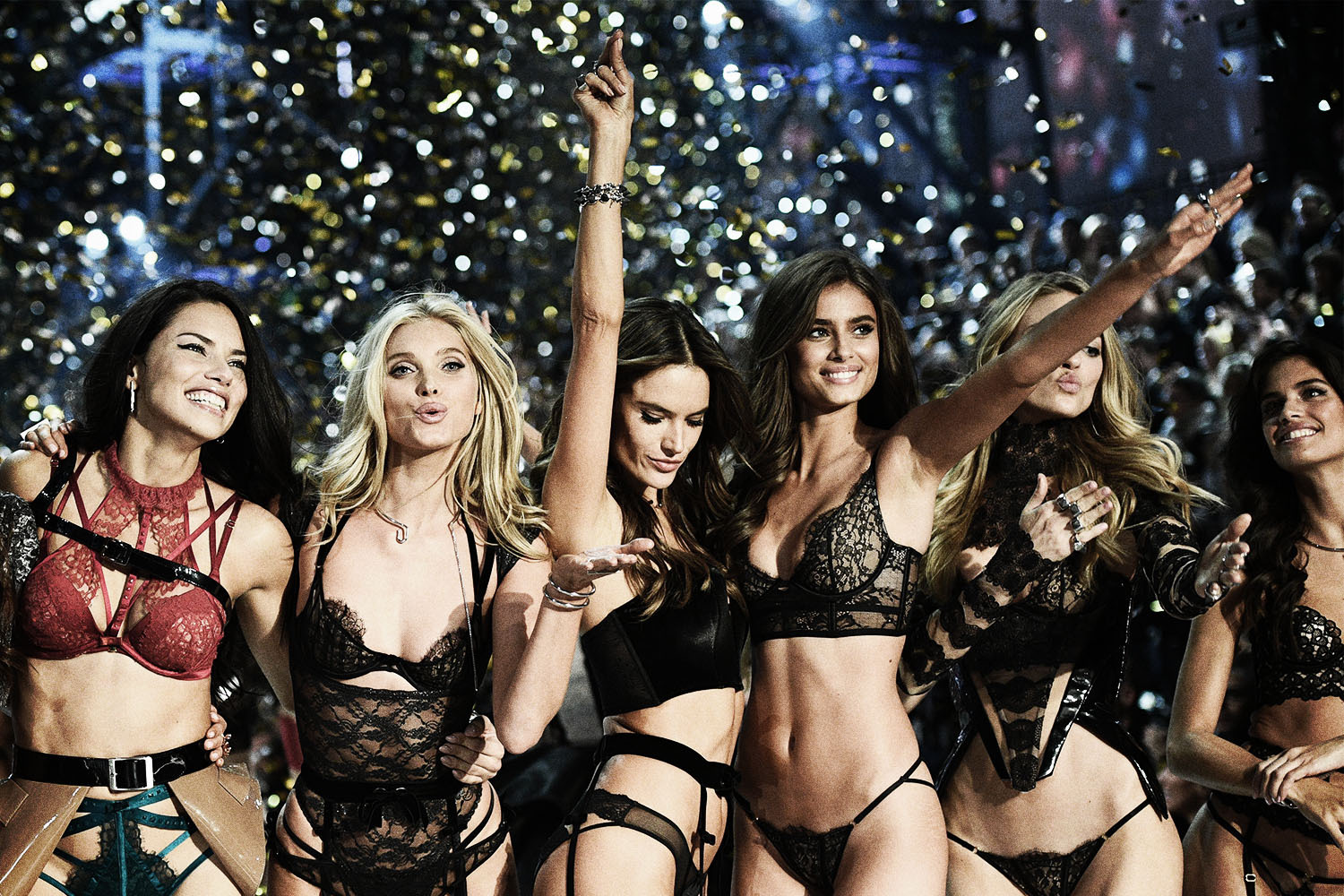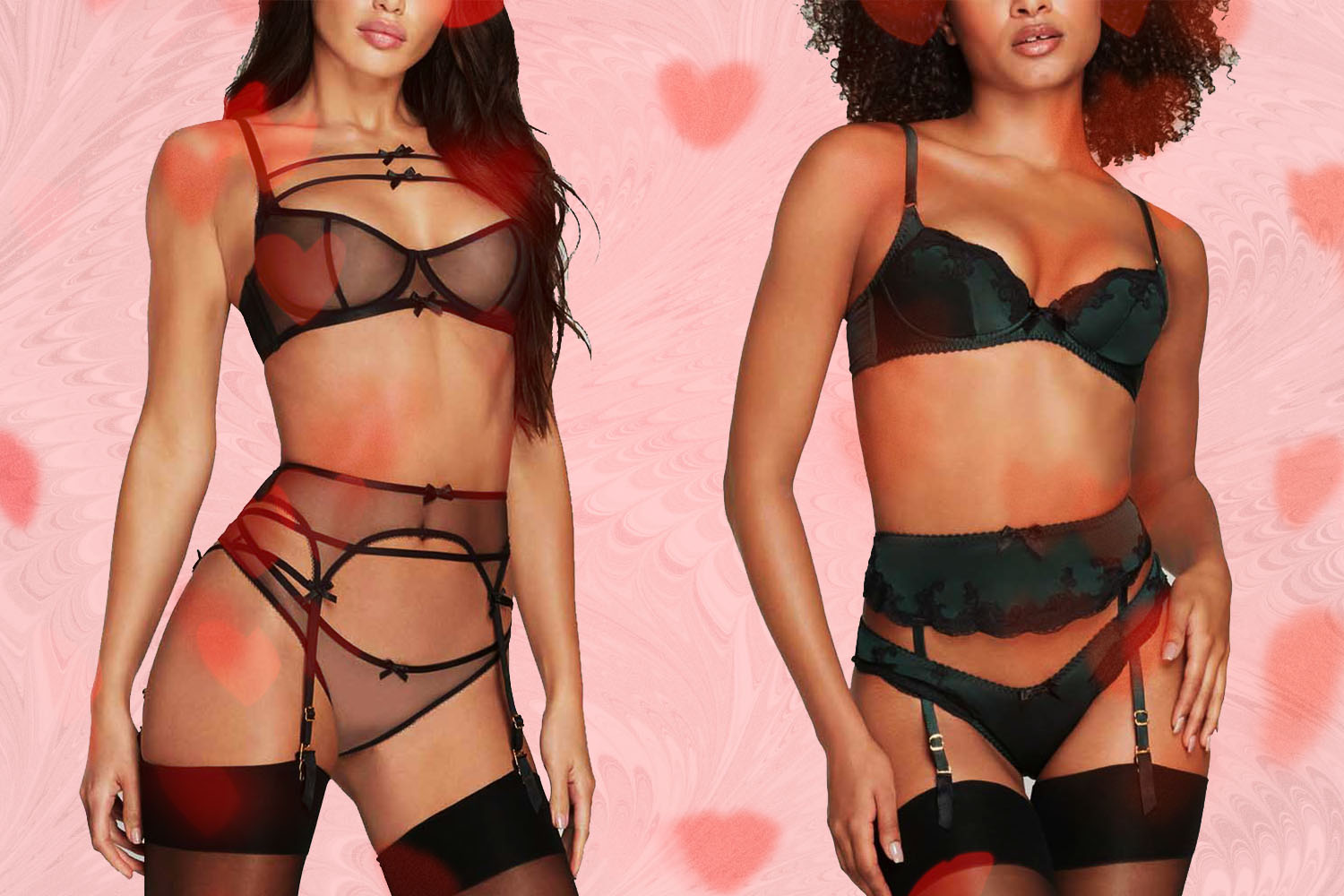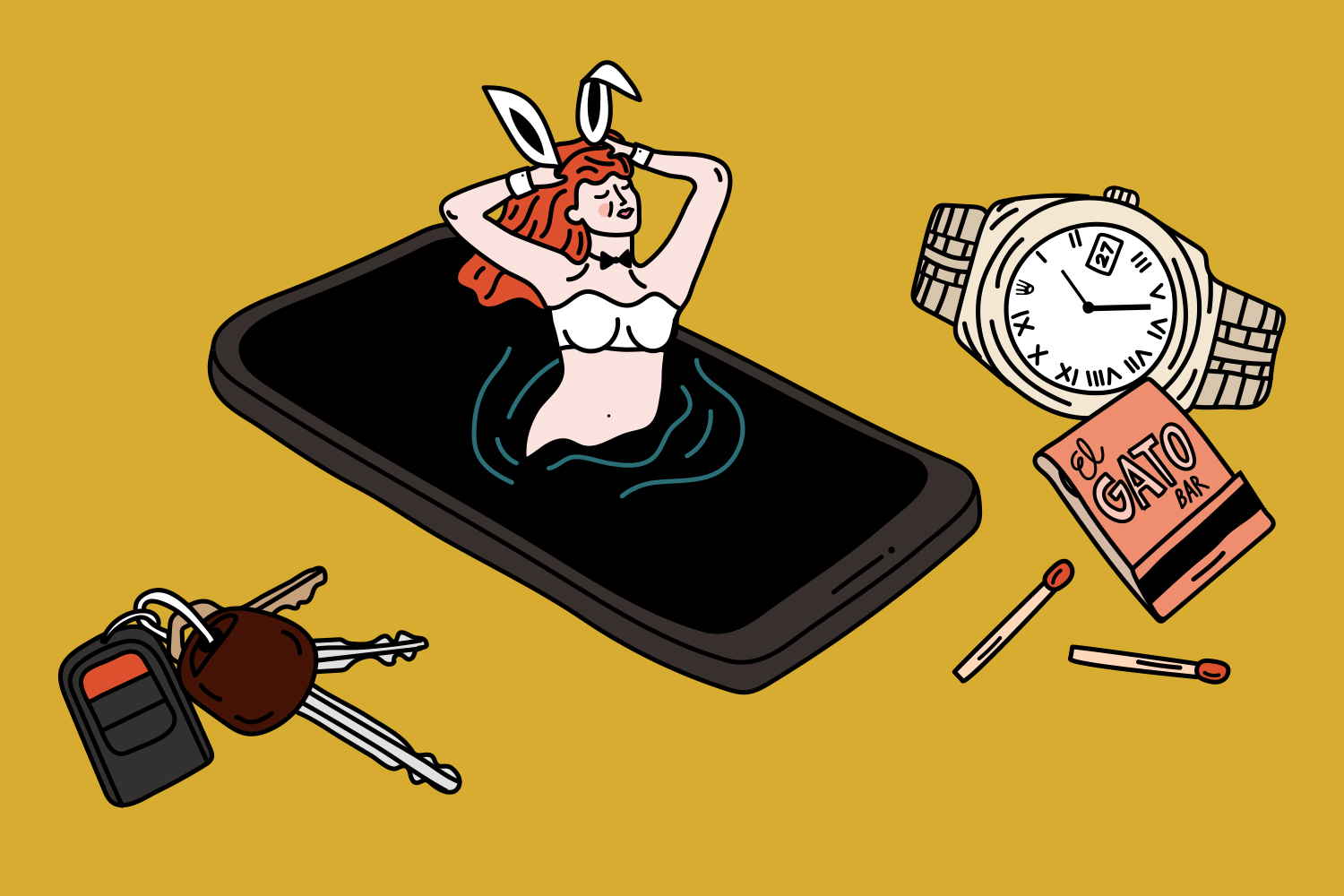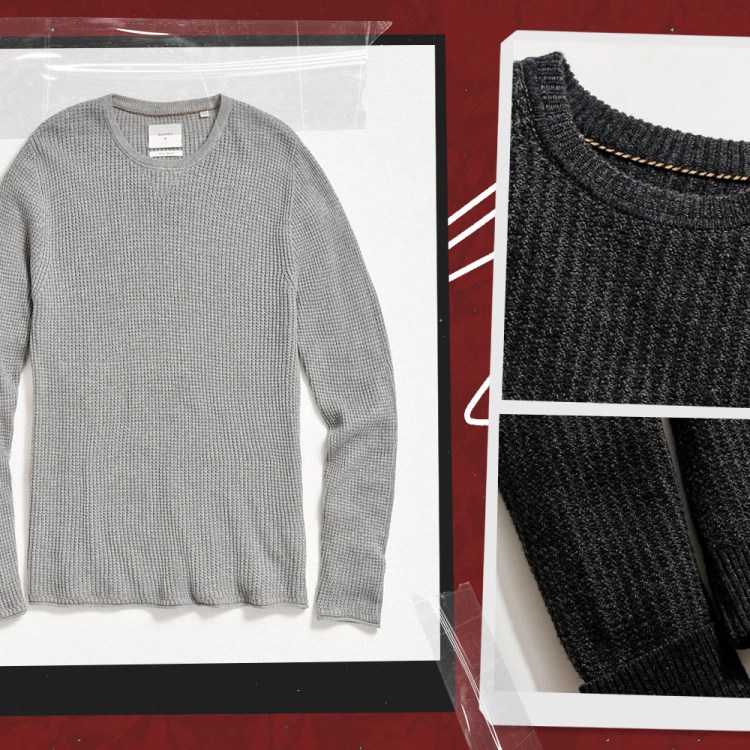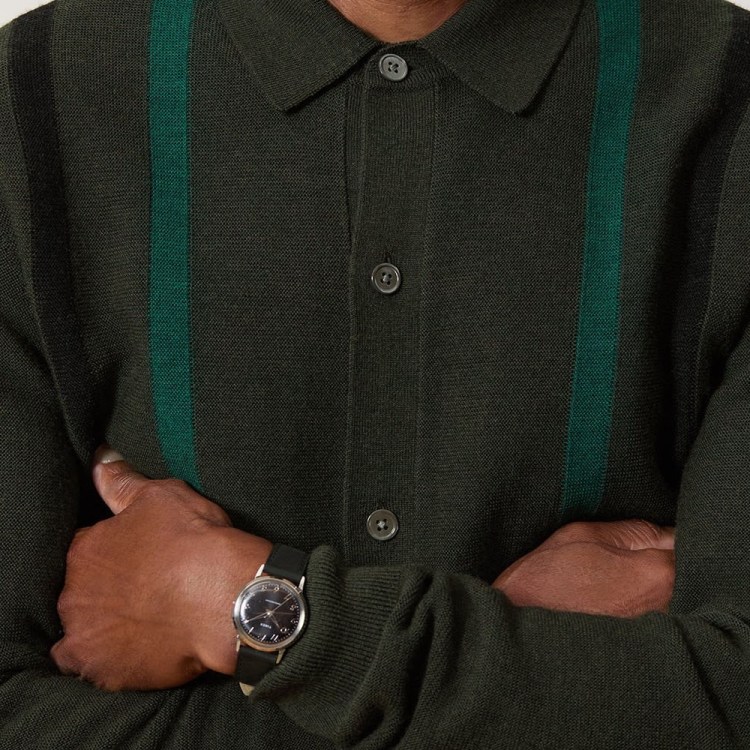When I first started wearing bras as a pre-teen in the late aughts, the idea of wearing anything other than a push-up bra was unimaginable. At the time, a still-dominant Victoria’s Secret seemed to be channeling most of its advertising budget into promoting the coveted “Bombshell Bra,” a stiff, foam contraption that promised to “add two cup sizes” to its wearer’s chest, and the brand had also launched a successful swimwear line hawking underwire bikini tops so heavily padded that you had to physically squeeze the water out of them after exiting the pool. It was uncomfortable, sure, but not nearly as uncomfortable as the idea of your breasts sitting anywhere near where god and nature intended them to be. If your tits weren’t hoisted up and squeezed together at all times via a contraption of hooks, wires and heavy padding, you might as well just admit you’d given up on your appearance entirely.
It was the last gasp of a cultural fixation on big breasts, specifically of the obviously fake, cartoonishly large variety that seemed all but mandatory for the Playmates who helmed the Playboy empire throughout the ’90s and early 2000s, before the brand entered a decade of decline peppered with multiple overhauls and rebrands. I’d grown up watching Hugh Hefner’s three girlfriends and their matching sets of D-cups bounce around the Playboy Mansion on the E! reality show, The Girls Next Door, and I remember reading somewhere that then-girlfriend Holly Madison had maxed out three credit cards at age 18 to buy her first set of implants. I couldn’t wait until the day I, too, could celebrate reaching legal adulthood by going into massive credit card debt for a brand new pair of obviously fake tits. Until then, however, at least I had my push-up bras.
Fortunately, before I had a chance to destroy my credit, a major cultural shift had taken place. By the time I turned 18 in the mid-2010s, E! had swapped Playboy balloon tits for Kardashian butts, and the burgeoning age of the ass gradually pushed boobs to the back burner. The bralette gained popularity, as did bralessness, and Victoria’s Secret had begun the descent into an increasingly rapid decline that would see the once powerful brand hit rock-bottom by the end of the decade. Meanwhile, attitudes toward breasts themselves shifted so dramatically that having a pronounced sexual interest in them somehow became synonymous with ignorance and a certain brand of rural conservatism, all of which saw the push-up bra rapidly pivot from a must-have undergarment to a dated, almost comical relic of a bygone era of women’s fashion and sexuality.
I haven’t owned a push-up bra since high school, and it’s been at least two years since I’ve purchased any kind of bra at all. In retrospect, this change seems to have happened overnight: one day our tits were pushed up to our ears and I couldn’t imagine them being anywhere else, the next they rested unobtrusively in unlined lace bralettes, or simply unencumbered by any kind of undergarment at all. But what really happened to the push-up bra, and will that ultra-padded boulder holster ever rise once more from the ashes of the dated era of pushed-up, airbrushed, one-size-fits-all sexuality it represented?
The rise of the push-up bra
The push-up bra has various origin stories spanning multiple decades. Some trace its origins back to the “bust supporters” and “improvers” of the Victorian era; others consider Fredrick Mellinger, of Frederick’s of Hollywood, the father of the push-up bra, and still others claim the push-up bra as we know it today didn’t appear until the 1960s, when Canadian designer Louise Poirier created the iconic Wonderbra.
“In fashion, it can be difficult to assess who was the first person to invent something, especially when a product becomes ubiquitous or when several companies develop an idea around the same time,” says Cora Harrington, founder and editor in chief of The Lingerie Addict and author of In Intimate Detail: How to Choose, Wear, and Love Lingerie.
What most lingerie experts and historians agree on, however, is that the biggest push-up bra boom in recent memory took hold in the last decade of the 20th century. “I’d say its peak was probably the 1990s when Baywatch was popular and stars like Pam Anderson started to normalize ‘breast implant boobs’ and those perfectly round breasts became the desirable shape,” says Jené Luciani Sena, bestselling author of The Bra Book and creator of The GemBra. Inspired by the growing popularity of the Anderson silhouette, “breast augmentations were booming,” says Luciani Sena, and those that couldn’t or didn’t go the surgical route relied on temporary augmentation via heavy padding and underwire instead.
By 1994, Wonderbra’s infamous “Hello Boys” billboard starring Eva Herzigova cemented the push-up bra’s status as a must-have undergarment, becoming one of the most iconic ads of all time in the process. It didn’t take long for Victoria’s Secret to latch onto the trend, quickly pivoting to the “all push-up bras, all the time” marketing position, as Harrington puts it, upon which the brand built the bombshell aesthetic that would carry Victoria’s Secret through its 2000s heyday.
What’s pushed up must come down
By the mid-2010s, however, Victoria’s Secret had entered a period of decline that would increase rapidly throughout the rest of the decade, and so had the pushed-up, blown-out, pin-up Barbie version of female sexuality on which the brand had built its crumbling empire.
The last time the now-defunct Victoria’s Secret Angels walked the runway at the also-defunct Victoria’s Secret Fashion Show in 2018, the brand was already facing a slew of problems that would only intensify in the coming years, including declining sales, controversial comments from then-Chief Marketing Officer Ed Razek and competition from other retailers who had taken the hint and adopted more inclusive product lines and marketing strategies. But the real problem, as Jess Cartner-Morley wrote for The Guardian at the time, was that Victoria’s Secret was “selling the wrong kind of cleavage.” Bralettes and bralessness had been gaining popularity for years at that point, but when the Angels took what would be their last strut down the doomed Victoria’s Secret runway that year, they were still rocking ample, pushed-up cleavage — a sure sign that the brand had failed to evolve from its increasingly dated “bombshell” aesthetic and the narrow, exclusive version of beauty it represented.
“The turning point for the push-up bra came in the mid-2010s,” says fashion historian Caroline Elenowitz-Hess, citing the backlash to Victoria’s Secret’s disastrous 2014 “Perfect Body” campaign as “a clear indication that Victoria’s Secret’s monolithic beauty standard, and the push-up bra that played an important part in supporting it, was on its way out.”
While, as Harrington notes, “it’s worth remembering that all trends are cyclical and it’s entirely normal for bralettes and, subsequently, unlined bras to emerge as a response to decades of popularity of the push-up bra,” the garment’s decline seems to reflect not just changing styles, but changing attitudes. “We begin to see bralettes emerge as a developing trend around 2013/2014, which is also the beginning of Victoria’s Secret’s precipitous decline,” says Harrington. That timing hardly seems coincidental.
“Although shifts in silhouette are often cyclical, I do think that the decline of the push-up bra is connected to a rejection of the narrow beauty standard which held that push-up bras were often meant to ‘correct’ perceived inadequacies,” says Elenowitz-Hess. “The limited culture of beauty illustrated by the Victoria’s Secret Angels — and echoed in the wider culture of the 1990s and early 2000s — made it clear that the push-up bra would ‘fix’ what nature had gotten wrong, and make the wearer desirable to a male partner.”
The simultaneous rise of social media played a role as well. The growing popularity of online platforms like Reddit, Twitter, Instagram and personal lingerie blogs gave rise to the body positive movement that directly opposed the version of prescriptive female beauty and male-gazey sexuality the push-up bra embodied. The rising influence of these online communities “highlighted a breadth of beauty ideals and subcultures and a growing acceptance of a variety of gender expressions, while also offering a platform for complaints against brands seen as exclusionary,” says Elenowitz-Hess.
Shifting notions of gender also informed the movement toward less exaggerated cleavage. “The decline in the push-up bra most notably reflects a change in attitude towards identity and the multitude of bodies that wear bras,” says Kadian Gosler, a PhD candidate in fashion and wearable technology, visiting practitioner at London College of Fashion and lingerie designer. “Bra wearers are not just cis-women but also trans-women and non-binaries. With this shift, we see a willingness and openness to accept the various identities and bodies that wear bras.” Gone is the “perfectly rounded, full, lifted and youthful” aesthetic long promoted as the ideal and rooted in a narrow, female-specific image of breasts and bra-wearers. Now, says Gosler, “We see smaller brands supporting this with older models, trans models and men modeling lingerie.” Even Victoria’s Secret, however too little or late they may be, is finally trying to catch up with the times, introducing the more size- and gender-inclusive “VS Collective” in place of its fallen Angels.
Does anyone even care about boobs anymore?
It’s also worth noting that the decline of the push-up bra coincided with a waning interest in breasts altogether. While it’s hard to argue breasts themselves ever go out of fashion — sure, different kinds of cleavage and silhouettes have gone in and out of style for as long as there have been breasts and fashion, but tits themselves are always en vogue, no? — 2010s culture saw the bust replaced as the sexual focus of the female body by a southern rival: the ass.
The rise of the ass can be attributed to — or is at least reflective of — many cultural influences: the Kardashians, mainstream appropriation of Black culture, and even, perhaps, the growing shift toward gender neutrality. After all, breasts — particularly of the perfectly round, pushed-up variety — had long been associated with cis-womanhood, but everyone has an ass.
By the mid-2010s, Kim Kardashian and her famous backside had become the most iconic sex symbol of her time, Nikki Minaj was invoking Sir Mix-a-Lot in her own iconic ode to ample asses, and any lingering taboos around anal sex were well on their way to extinction.
Meanwhile, the big butts of the 2010s quickly eclipsed the cleavage that dominated the previous decades. By 2017, new data from Pornhub charting a decline in boob-related searches prompted a flurry of editorials declaring a then-still-relevant millennial generation was no longer interested in tits at all. In recent years, multiple celebrities have reportedly had their implants removed, and as Luciani Sena notes, those who are still opting for surgical enhancement today are typically pursuing more natural, tear-drop shapes, rather than the massive round globes that filled chests throughout the ’90s and 2000s.
Again, whether or not people will ever truly turn their backs on boobs remains up for debate, but as Miles Klee noted for Mel Magazine last year, breasts seem to have fallen out of fashion to the extent that any publicly displayed preference for them has taken on unsavory, perhaps surprisingly political connotations.
Whether or not breasts themselves will ever lose their sex appeal behind closed doors, the message in recent years has been clear: ass is in, tits are out — but no longer in the literal sense.
Is there a future for the push-up bra?
Of course, trends are cyclical, and we are currently in the midst of an early-aughts revival. In recent years, various fashions from the ‘90s and early 2000s have made or at least threatened to make comebacks, from whale tails and low-rise jeans to scrunchies and butterfly tops. If even Ben Affleck and Jennifer Lopez can pull off a revival, might we be on the precipice of a great push-up bra renaissance?
“I think almost everything makes a comeback at some point, if for no other reason than there are few things which are truly ‘new’ in intimate apparel,” says Harrington.
“The push-up bra will certainly return. All trends do, even in the lingerie world,” echoes Gosler. After all, she adds, “The push-up bra was not to blame for its downfall, but what it represented.” New generations of bra wearers, perhaps in the next 30 to 40 years, per Gosler’s estimate, may no longer see the push-up bra as the tawdry vestige of dated, unrealistic beauty standards with which often braless breast-owners of today currently associate the garment.
Elenowitz-Hess, for her part, doesn’t think it will take nearly that long for the push-up bra to find itself back in fashion’s good graces. “I definitely believe that the push-up bra will return as a mainstream trend,” she tells InsideHook, “and the embrace of ‘Y2K’ styles by Gen Z suggests that it may be sooner rather than later.”
Gen Z’s early-aughts romanticizing aside, bra-wearers may find themselves eventually gravitating back towards the push-up bra simply because there was a reason people wanted to lift their breasts in the first place. As Luciani Sena puts it, “There are some women who just feel sexier with bigger or more boosted breasts. No one likes sagging or admitting they’re aging!”
Of course, whenever the push-up bra does make its seemingly inevitable return to the forefront of lingerie fashion, it may take a slightly different form. “The next iteration of the padded or push-up bra may not look the same,” says Harrington. “After all, the Frederick’s push-up bra of the 1940s looked different from the Victoria’s Secret bra of the 2000s — but everything that goes around comes around.”
This article appeared in an InsideHook newsletter. Sign up for free to get more on travel, wellness, style, drinking, and culture.
